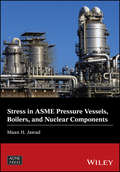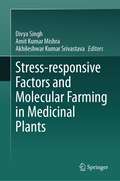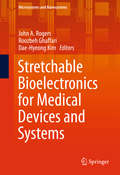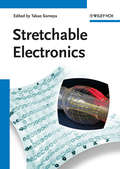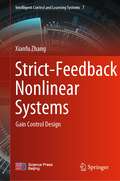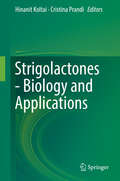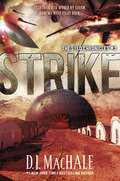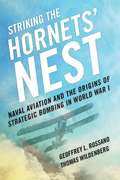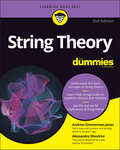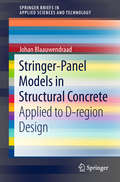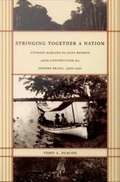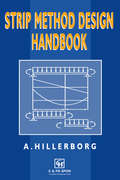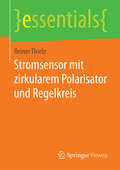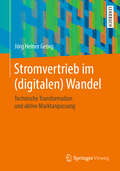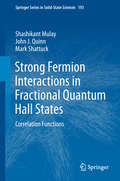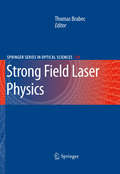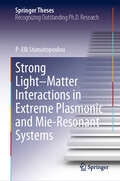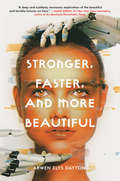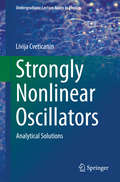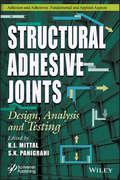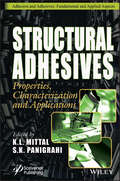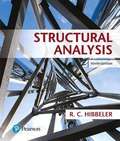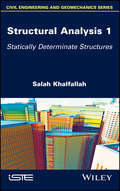- Table View
- List View
Stress in ASME Pressure Vessels, Boilers, and Nuclear Components
by Maan H. JawadAn illustrative guide to the analysis needed to achieve a safe design in ASME Pressure Vessels, Boilers, and Nuclear Components Stress in ASME Pressure Vessels, Boilers, and Nuclear Components offers a revised and updatededition of the text, Design of Plate and Shell Structures. This important resource offers engineers and students a text that covers the complexities involved in stress loads and design of plates and shell components in compliance with pressure vessel, boiler, and nuclear standards. The author covers the basic theories and includes a wealth of illustrative examples for the design of components that address the internal and external loads as well as other loads such as wind and dead loads. The text keeps the various derivations relatively simple and the resulting equations are revised to a level so that they can be applied directly to real-world design problems. The many examples clearly show the level of analysis needed to achieve a safe design based on a given required degree of accuracy. Written to be both authoritative and accessible, this important updated book: Offers an increased focus on mechanical engineering and contains more specific and practical code-related guidelines Includes problems and solutions for course and professional training use Examines the basic aspects of relevant theories and gives examples for the design of components Contains various derivations that are kept relatively simple so that they can be applied directly to design problems Written for professional mechanical engineers and students, this text offers a resource to the theories and applications that are needed to achieve an understanding of stress loads and design of plates and shell components in compliance with pressure vessel, boiler, and nuclear standards.
Stress-responsive Factors and Molecular Farming in Medicinal Plants
by Amit Kumar Mishra Divya Singh Akhileshwar Kumar SrivastavaThis contributed volume brings out a comprehensive collection of changes from cellular to molecular levels in medicinal plants under extreme environments. The focus of this book is to address the molecular changes in medicinal plants under different abiotic stresses. Medicinal plants are regarded as rich resources of components that can be used for drug development in the pharmaceutical industry. A few medicinal plants are considered vital sources of nutrients and solicited for their therapeutic properties. Therefore, it is essential to understand medicinal plants' interaction under abiotic stresses as compounds obtained from these plants play an important role in human health. This book is of interest to students, teachers, researchers, scientists, medicinal plant experts, and policymakers. Also, the book provides study material for undergraduate and graduate students of botany, environmental sciences, medicinal and aromatic plants, biochemistry, and biotechnology. National and international scientists working in the area of medicinal plants, drug development, and policymakers will also find this a useful read
Stretchable Bioelectronics for Medical Devices and Systems
by John A. Rogers Roozbeh Ghaffari Dae-Hyeong KimThis book highlights recent advances in soft and stretchable biointegrated electronics. A renowned group of authors address key ideas in the materials, processes, mechanics, and devices of soft and stretchable electronics; the wearable electronics systems; and bioinspired and implantable biomedical electronics. Among the topics discussed are liquid metals, stretchable and flexible energy sources, skin-like devices, in vitro neural recording, and more. Special focus is given to recent advances in extremely soft and stretchable bio-inspired electronics with real-world clinical studies that validate the technology. Foundational theoretical and experimental aspects are also covered in relation to the design and application of these biointegrated electronics systems. This is an ideal book for researchers, engineers, and industry professionals involved in developing healthcare devices, medical tools and related instruments relevant to various clinical practices.
Stretchable Electronics
by Takao SomeyaOn a daily basis, our requirements for technology become more innovative and creative and the field of electronics is helping to lead theway to more advanced appliances. This book gathers and evaluates the materials, designs, models, and technologies that enable the fabrication of fully elastic electronic devices that can tolerate high strain. Written by some of the most outstanding scientists in the field, it lays down the undisputed knowledge on how to make electronics withstand stretching. This monograph provides a review of the specific applications that directly benefit from highly compliant electronics, including transistors, photonic devices, and sensors. In addition to stretchable devices, the topic of ultraflexible electronics is treated, highlighting its upcoming significance for the industrial-scale production of electronic goods for the consumer.Divided into four parts covering:* Theory* Materials and Processes* Circuit Boards* Devices and ApplicationsAn unprecedented overview of this thriving area of research that nobody in the field - or intending to enter it - can afford to miss.
Strict-Feedback Nonlinear Systems: Gain Control Design (Intelligent Control and Learning Systems #7)
by Xianfu ZhangThis book describes the research progress of the control design about strict-feedback nonlinear systems. A novel gain control design method is proposed, which greatly simplifies the construction procedure of controller for strict-feedback nonlinear systems. The control design problem of strict-feedback nonlinear systems is converted into the determination problem of gain parameters or the construction of dynamic gain equations. Therefore, the tedious iterative design procedure is effectively avoided. This book can be used as a reference for researchers in the field of control theory and engineers seeking advanced methods in practical control applications.
Strigolactones - Biology and Applications
by Hinanit Koltai Cristina PrandiThis book describes the exciting biology and chemistry of strigolactones. Outgrowth of shoot branches? Development of lateral roots? Interactions with beneficial microorganisms? Avoiding parasitic plants? Responding to drought conditions? These important “decisions” that plants make are all regulated by a group of hormones called strigolactones.The latest research has yielded a number of new biological concepts, such as a redefinition of plant hormones and their crosstalk, new functional diversity of receptors, hormonal “smoke and mirrors,” core signaling pathways, and even phloem transport of receptor proteins. Another important aspect of strigolactones is the related synthetic chemistry, which could pave the way for a variety of potential applications in agriculture and medicine.The book explains in detail the role that strigolactones play in plant development, and addresses the interaction of plants with soil biota and abiotic stress conditions, prospects of strigolactone biochemistry and evolution, and chemical synthesis of natural strigolactones and analogs, together with their potential applications. Including a glossary and end-of-chapter synopses to aid in comprehension, it offers a valuable asset for teachers, lecturers and (post-) graduate students in biology, agronomy and related areas..
Strike: The SYLO Chronicles #3 (The SYLO Chronicles #3)
by D. J. MacHale#1 New York Times bestselling author D.J. MacHale is back with the third book in the SYLO Chronicles. Once again, Tucker Pierce and friends must fight for their lives against the better-equipped SYLO. All bets are off in Strike--with twists so big readers will never see them coming--while the action and pulse-pounding suspense remain as high as ever. Fans will be sure to devour this incredibly satisfying conclusion.Praise for the SYLO Chronicles: "A relentlessly fast-paced, intriguing, expertly-written tale that leaves you breathless and satisfied, yet wanting more. Highly recommended."--James Dashner, New York Times bestselling author of the Maze Runner series "Absolutely un-put-downable, more exciting than an Xbox and roller coaster combined."--Kirkus, starred review"If you're a fan of The Maze Runner and Alex Rider, you might want to pick up SYLO. . . . A fast-paced read and a huge cliffhanger."--EW.com"With this extremely high-octane story that's the equivalent to a summer movie blockbuster, MacHale kicks off an apocalyptic trilogy sure to leave readers demanding the next installment."--Booklist"This action-filled, end-of-the-world-as-we-know-it adventure . . . should leave teen readers clamoring for the next installment."--VOYA"An entertaining and creepy tale."--Publishers Weekly"MacHale pens some terrific and unique action scenes. . . will leave readers hungry for the next installment."--School Library Journal
Striking The Hornets' Nest: Naval Aviation And The Origins Of Strategic Bombing In World War I
by Thomas Wildenberg Geoffrey L. RossanoStriking the Hornets’ Nest provides the first extensive analysis of the Northern Bombing Group (NBG), the Navy’s most innovative aviation initiative of World War I and one of the world’s first dedicated strategic bombing programs. Very little has been written about the Navy’s aviation activities in World War I and even less on the NBG. Standard studies of strategic bombing tend to focus on developments in the Royal Air Force or the U. S. Army Air Service. This work concentrates on the origins of strategic bombing in World War I, and the influence this phenomenon had on the Navy’s future use of the airplane. The NBG program faced enormous logistical and personnel challenges. Demands for aircraft, facilities, and personnel were daunting, and shipping shortages added to the seemingly endless delays in implementing the program. Despite the impediments, the Navy (and Marine Corps) triumphed over organizational hurdles and established a series of bases and depots in northern France and southern England in the late summer and early fall of 1918. Ironically, by the time the Navy was ready to commence bombing missions, the German retreat had caused abandonment of the submarine bases the NBG had been created to attack. The men involved in this program were pioneers, overcoming major obstacles only to find they were no longer needed. Though the Navy rapidly abandoned its use of strategic bombing after World War I, their brief experimentation directed the future use of aircraft in other branches of the armed forces. It is no coincidence that Robert Lovett, the young Navy reserve officer who developed much of the NBG program in 1918, spent the entire period of World War II as Assistant Secretary of War for Air where he played a crucial role organizing and equipping the strategic bombing campaign unleashed against Germany and Japan. Rossano and Wildenberg have provided a definitive study of the NBG, a subject that has been overlooked for too long.
String Theory For Dummies
by Andrew Zimmerman Jones Alessandro SfondriniUnravel the secrets of the universe and untangle cutting-edge physics Yes, you actually can understand quantum physics! String Theory For Dummies is a beginner’s guide, and we make it fun to find out about the all the recent trends and theories in physics, including the basics of string theory, with friendly explanations. Build a foundation of physics knowledge, understand the various string theories and the math behind them, and hear what the opponents to string theory have to say. It’s an exciting time to be alive in advanced physics, and this updated edition covers what’s new in the string world—the Large Hadron Collider, the Higgs Boson, gravitational waves, and lots of other big headlines. Unleash your inner armchair physicist with String Theory For Dummies. Brush up on the basics of physics and the approachable math needed to understand string theory Meet the scientists who discovered string theory and continue to make waves (and particles) in the physics world Understand what it’s all about with real-world examples and explanations Learn why string theory is called "The Theory of Everything"—and what it means for technology and the future Aspiring scientists or life-long learners will both be able to gain valuable information from this book. This accessible intro into string theory is for the theorists inside anyone.
Stringer-Panel Models in Structural Concrete: Applied to D-region Design (SpringerBriefs in Applied Sciences and Technology)
by Johan BlaauwendraadStructural concrete designers nowadays distinguish between B-regions (named after Bernoulli beam theory) and D-regions (D standing for ‘disturbed’). They are all familiar with B-regions, but less acquainted with the expertise required for D-regions. To design D-regions, the Strut-and-Tie Model (STM) is usually applied, a model laid down worldwide in structural codes of practice. The Stringer-Panel Model (SPM) recommended here is a companion method to the STM, with the advantage of being suitable for different load cases and reversed loading. This being so, the SPM is suitable for linear-elastic analyses where durability is a key consideration, but also suits structural design for contexts of cyclical seismic activity. Finally, this book sets out how structural engineers who prefer the STM can nevertheless apply the SPM to determine a proper strut-and-tie model.
Stringing Together a Nation: Cândido Mariano Da Silva Rondon and the Construction of a Modern Brazil, 1906-1930
by Todd A. DiaconFocusing on one of the most fascinating and debated figures in the history of modern Brazil, Stringing Together a Nation is the first full-length study of the life and career of Cndido Mariano da Silva Rondon (1865-1958) to be published in English. In the early twentieth century, Rondon, a military engineer, led what became known as the Rondon Commission in a massive undertaking: the building of telegraph lines and roads connecting Brazil's vast interior with its coast. Todd A. Diacon describes how, in stringing together a nation with telegraph wire, Rondon attempted to create a unified community of "Brazilians" from a population whose loyalties and identities were much more local and regional in scope. He reveals the work of the Rondon Commission as a crucial exemplar of the issues and intricacies involved in the expansion of central state authority in Brazil and in the construction of a particular kind of Brazilian nation. Using an impressive array of archival and documentary sources, Diacon chronicles the Rondon Commission's arduous construction of telegraph lines across more than eight hundred miles of the Amazon Basin; its exploration, surveying, and mapping of vast areas of northwest Brazil; and its implementation of policies governing relations between the Brazilian state and indigenous groups. He considers the importance of Positivist philosophy to Rondon's thought, and he highlights the Rondon Commission's significant public relations work on behalf of nation-building efforts. He reflects on the discussions--both contemporaneous and historiographical--that have made Rondon such a fundamental and controversial figure in Brazilian cultural history.
Strip Method Design Handbook
by A. HillerborgThe Strip Method Design Handbook is a thorough guide to the use of the strip method, developed by Arne Hillerborg, for design of reinforced concrete slabs. The strip method of design is relevant to many types of slabs including rectangular slabs with all sides supported and regular flat slabs with cantilevering parts. The author discusses unevenly
Stromsensor mit zirkularem Polarisator und Regelkreis (essentials)
by Reiner ThieleReiner Thiele bearbeitet ein grunds#65533;tzliches Problem der Messtechnik: die potenzialgetrennte Messung elektrischer Str#65533;me ohne Eingriff in den Stromkreis der Messgr#65533;#65533;e. Die L#65533;sung ist die Schaltungsanordnung eines reflektierenden Stromsensors zur Messung elektrischer Str#65533;me mit automatischer Kompensation der Doppelbrechung und streng linearer Beziehung zwischen Messwerten und -gr#65533;#65533;e. Wiederholt gelang dem Autor mit dieser Erfindung die exakte L#65533;sung einer nichtlinearen Differenzialgleichung (DGL), die diese Schaltungsanordnung beschreibt. Au#65533;erdem appliziert er einen rechts- oder linksdrehenden zirkularen Polarisator zur messgr#65533;#65533;enabh#65533;ngigen Ver#65533;nderung der transversalen Komponente einer elektrischen Verschiebungsflussdichte in den Sensor-Lichtwellenleitern (LWL).
Stromvertrieb im (digitalen) Wandel: Technische Transformation und aktive Marktanpassung
by Jörg Heiner GeorgIn diesem Lehrbuch wird ein grundlegendes Verständnis für Geschäftsmodelle speziell im Stromvertrieb vermittelt und wesentliche Funktionen des Betriebsmodells (Aufbau- und Ablauforganisation) erklärt. Dabei hat der Autor auf auf Praxisbezug Wert gelegt und sowohl die Treiber der Digitalisierung als auch die Wirkungsmechanismen der Transformation sowie datengetriebene Geschäftsmodelle beschrieben. Architektur und systematischer Aufbau möglicher Geschäftsmodelle sind anhand von Teilmodellen nachvollziehbar dargestellt und veranschaulicht. Das Buch hilft Studierenden energietechnischer, energiewirtschaftlicher und angrenzender Fachbereiche aktuelle Modelle zu verstehen, zu analysieren und schafft damit die Grundvoraussetzung diese Kenntnisse im späteren Berufsleben einzusetzen.
Strong Fermion Interactions in Fractional Quantum Hall States: Correlation Functions (Springer Series In Solid-state Sciences Ser. #193)
by John J. Quinn Shashikant Mulay Mark ShattuckThis monograph presents an intuitive theory of trial wave functions for strongly interacting fermions in fractional quantum Hall states. The correlation functions for the proposed fermion interactions follow a novel algebraic approach that harnesses the classical theory of invariants and semi-invariants of binary forms. This approach can be viewed as a fitting and far-reaching generalization of Laughlin’s approach to trial wave functions. Aesthetically viewed, it illustrates an attractive symbiosis between the theory of invariants and the theory of correlations. Early research into numerical diagonalization computations for small numbers of electrons shows strong agreement with the constructed trial wave functions.The monograph offers researchers and students of condensed matter physics an accessible discussion of this interesting area of research.
Strong Field Laser Physics
by Thomas BrabecDue to the rapid progress in laser technology a wealth of novel fundamental and applied applications of lasers in atomic and plasma physics have become possible. This book focuses on the interaction of high intensity lasers with matter. It reviews the state of the art of high power laser sources, intensity laser-atom and laser-plasma interactions, laser matter interaction at relativistic intensities, and QED with intense lasers.
Strong Light–Matter Interactions in Extreme Plasmonic and Mie-Resonant Systems (Springer Theses)
by P. Elli StamatopoulouCollective excitations in matter, either in the form of plasmons in metals or Mie resonances in high-index dielectrics, constitute fundamental building blocks for photonic applications, including optical and quantum communications, biosensing, and polaritonic chemistry. Motivated by these prospects, this book explores excitations sustained in metallic and dielectric nanocavities and their interaction with light, quantum emitters, and swift electrons. The book presents analytic methods for describing the strong and weak coupling between spherical nanocavities and optical transitions in matter, while also analyzing the impact of nonlocality on the coupling, when considering extremely small metallic structures. Besides light-based spectroscopy, it examines electrons as sources for probing optical excitations in matter and provides analytic tools for simulating measurements in cathodoluminescence and electron energy-loss spectroscopy.
Strong-Coupling Theory of High-Temperature Superconductivity
by Alexandre S. AlexandrovHigh-temperature superconductivity has transformed the landscape of solid state science, leading to the discovery of new classes of materials, states of matter, and concepts. However, despite being over a quarter of a century since its discovery, there is still no single accepted theory to explain its origin. This book presents one approach, the strong-coupling or bipolaron theory, which proposes that high-temperature superconductivity originates from competing Coulomb and electron-phonon interactions. The author provides a thorough overview of the theory, describing numerous experimental observations, and giving detailed mathematical derivations of key theoretical findings at an accessible level. Applications of the theory to existing high-temperature superconductors are discussed, as well as possibilities of liquid superconductors and higher critical temperatures. Alternative theories are also examined to provide a balanced and informative perspective. This monograph will appeal to advanced researchers and academics in the fields of condensed matter physics and quantum-field theories.
Stronger, Faster, and More Beautiful
by Arwen Elys Dayton<P><P>For fans of television shows Black Mirror and Westworld, this compelling, mind-bending novel is a twisted look into the future, exploring the lengths we'll go to remake ourselves into the perfect human specimen and what it means to be human at all. <P><P>The future is curious. <P><P>STRONGER <P><P>Today our bodies define us. We color our hair; tattoo our skin; pierce our ears, brows, noses. We lift weights, run miles, break records. We are flesh and blood and bone. <P><P>FASTER <P><P>Tomorrow has different rules. The future is no longer about who we are--it's about who we want to be. If you can dream it, you can be it. Science will make us smarter, healthier, flawless in every way. Our future is boundless. <P><P>MORE BEAUTIFUL <P><P>This is a story that begins tomorrow. It's a story about us. It's a story about who comes after us. And it's a story about perfection. Because perfection has a way of getting ugly.
Strongly Correlated Fermi Systems: A New State of Matter (Springer Tracts in Modern Physics #283)
by Miron Amusia Vasily ShaginyanThis book focuses on the topological fermion condensation quantum phase transition (FCQPT), a phenomenon that reveals the complex behavior of all strongly correlated Fermi systems, such as heavy fermion metals, quantum spin liquids, quasicrystals, and two-dimensional systems, considering these as a new state of matter. The book combines theoretical evaluations with arguments based on experimental grounds demonstrating that the entirety of very different strongly correlated Fermi systems demonstrates a universal behavior induced by FCQPT. In contrast to the conventional quantum phase transition, whose physics in the quantum critical region are dominated by thermal or quantum fluctuations and characterized by the absence of quasiparticles, the physics of a Fermi system near FCQPT are controlled by a system of quasiparticles resembling the Landau quasiparticles. The book discusses the modification of strongly correlated systems under the action of FCQPT, representing the “missing” instability, which paves the way for developing an entirely new approach to condensed matter theory; and presents this physics as a new method for studying many-body objects. Based on the authors’ own theoretical investigations, as well as salient theoretical and experimental studies conducted by others, the book is well suited for both students and researchers in the field of condensed matter physics.
Strongly Nonlinear Oscillators
by Livija CveticaninThis book provides the presentation of the motion of pure nonlinear oscillatory systems and various solution procedures which give the approximate solutions of the strong nonlinear oscillator equations. The book presents the original author's method for the analytical solution procedure of the pure nonlinear oscillator system. After an introduction, the physical explanation of the pure nonlinearity and of the pure nonlinear oscillator is given. The analytical solution for free and forced vibrations of the one-degree-of-freedom strong nonlinear system with constant and time variable parameter is considered. Special attention is given to the one and two mass oscillatory systems with two-degrees-of-freedom. The criteria for the deterministic chaos in ideal and non-ideal pure nonlinear oscillators are derived analytically. The method for suppressing chaos is developed. Important problems are discussed in didactic exercises. The book is self-consistent and suitable as a textbook for students and also for professionals and engineers who apply these techniques to the field of nonlinear oscillations.
Structural Adhesive Joints: Design, Analysis, and Testing
by K. L. Mittal S. K. PanigrahiMost structures are comprised of a number of individual parts or components which have to be connected to form a system with integral load transmission path. The structural adhesive bonding represents one of the most enabling technologies to fabricate most complex structural configurations involving advanced materials (e.g. composites) for load-bearing applications. Quite recently there has been a lot of activity in harnessing nanotechnology (use of nanomaterials) in ameliorating the existing or devising better performing structural adhesives. The 10 chapters by subject matter experts look at the following issues: Surface preparation for structural adhesive joints (SAJ) Use of nanoparticles in enhancing performance of SAJ Optimization of SAJ Durability aspects of SAJ Debonding of SAJ Fracture mechanics of SAJ Failure analysis of SAJ Damage behavior in functionally graded SAJ Impact, shock and vibration characteristics of composites for SAJ Delamination arrest methods in SAJ
Structural Adhesives: Properties, Characterization and Applications
by K. L. Mittal S. K. PanigrahiStructural Adhesives Uniquely provides up-to-date and comprehensive information on the topic in an easily-accessible form. A structural adhesive can be described as a high-strength adhesive material that is isotropic in nature and bonds two or more parts together in a load-bearing structure. A structural adhesive material must be capable of transmitting the stress/load without loss of structural integrity within design limits. There are many types of established structural adhesives, including epoxy, urethane, acrylic, silicone, etc. Structural Adhesives comprises nine chapters and is divided into two parts: Part 1, Preparation, Properties, and Characterization; Part 2, Applications. The topics covered include: structural epoxy adhesives; biological reinforcement of epoxies as structural adhesives; marble dust reinforced epoxy structural adhesive composites; characterization of various structural adhesive materials; effects of shear and peel stress distributions on the behavior of structural adhesives; the inelastic response of structural aerospace adhesives; structural reactive acrylic adhesives: their preparation, characterization, properties, and applications; application of structural adhesives in composite connections; and naval applications of structural adhesives. Audience This book should be of much use and interest to adhesionists, materials scientists, adhesive technologists, polymer scientists, and those working in the construction, railway, automotive, aviation, bridge, and shipbuilding industries.
Structural Analysis
by Russell HibbelerStructural Analysis, 8e, provides readers with a clear and thorough presentation of the theory and application of structural analysis as it applies to trusses, beams, and frames. Emphasis is placed on teaching readers to both model and analyze a structure. Procedures for Analysis, Hibbeler's problem solving methodologies, provides readers with a logical, orderly method to follow when applying theory.
Structural Analysis 1: Statically Determinate Structures
by Salah KhalfallahUsing a general approach, this book supports the student to enable mastery of the methods of analysis of isostatic and hyperstatic structures. To show the performance of the methods of analysis of the hyperstatic structures, selected beams, gantries and reticular structures are selected and subjected to a comparative study by the different methods of analysis of the hyperstatic structures.
